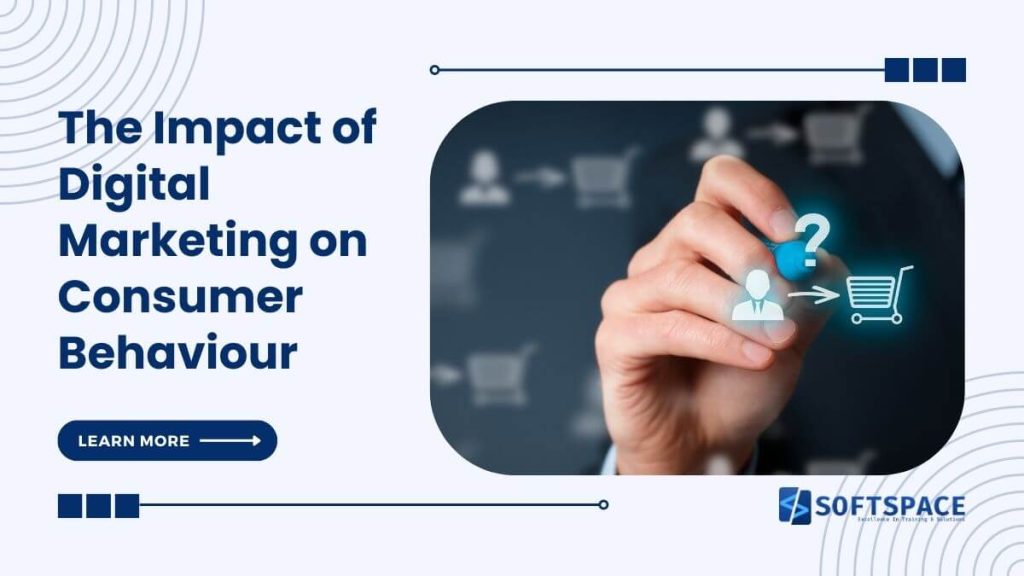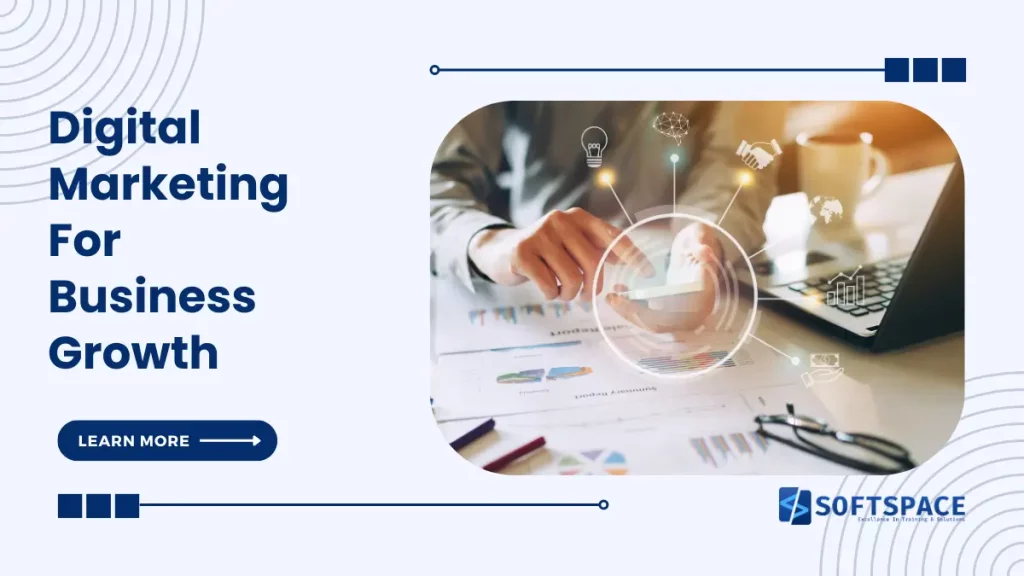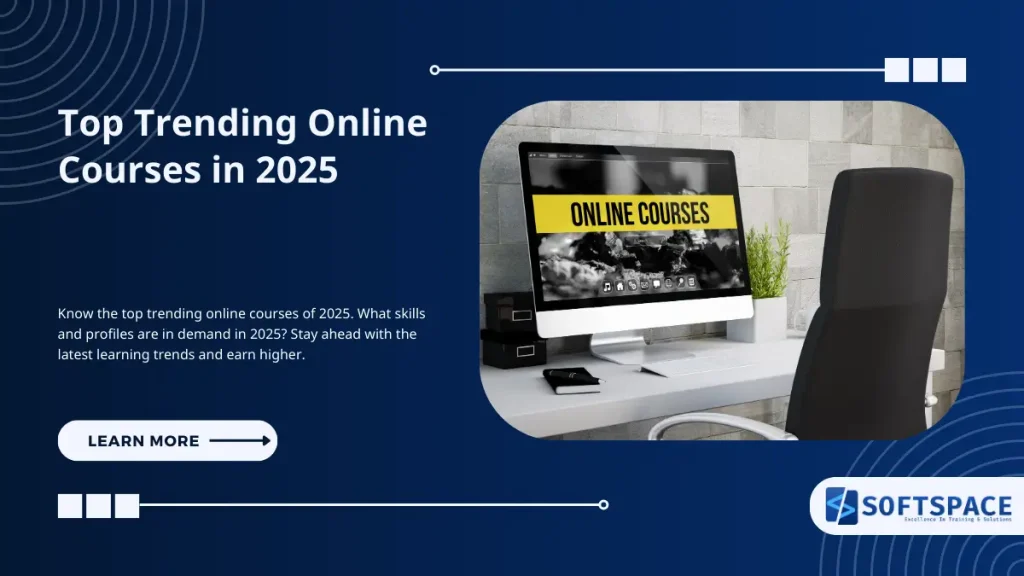In today’s digital age, consumers are constantly bombarded with information and advertisements from various sources. This has led to a significant shift in consumer behavior, as individuals are now more empowered than ever before to research, compare, and make informed purchasing decisions. Understanding the impact of digital marketing on consumer behaviour is critical for businesses aiming to thrive in the modern marketplace.
This article delves into the various aspects of digital marketing that influence consumer behavior, including the impact of social media, personalization, mobile marketing, and privacy concerns. Furthermore, it explores future trends in digital marketing and provides valuable insights for businesses to adapt their strategies and stay ahead of the curve.
Impact of digital marketing on consumer behaviour
Table of Contents
Influence of social media on consumer behaviour
Social media has become an integral part of our daily lives, with billions of people using platforms like Facebook, Instagram, and Twitter to connect with friends, family, and brands.
This widespread adoption of social media has had a profound impact on consumer behaviour, as individuals are now more empowered than ever before to research, compare, and make informed purchasing decisions.
Product Praising
- Product praise from satisfied consumers often takes the form of social media engagement in the form of likes, shares, reviews, and comments.
- To build trust in their business and boost conversion rates, marketers are publishing reviews, comments, likes, tweets, and pins from satisfied customers to make the social sphere more transparent.
- The cosmetics and beauty business is among the leading ones that capitalize on this social media client presence.
Social media has become an essential component of buyers’ and sellers’ lives, making the strength of social proof impossible to dispute.
Case studies, photos, videos, podcast interviews, and influencers are all forms of social proof that social marketers may use to bolster the credibility of their products. As a result, the conversion rate will rise with time.
Some Serious Facts & Stats
- 64% of online buyers wait to buy items until they are on sale.
- 49% of consumers seek advice from social media influencers before making a purchase decision.
- According to a Deloitte survey, social media-influenced consumers are four times more likely to spend more money on their purchases.
- 29% of consumers are more inclined to make a purchase the same day they use social media.
There are certain advantages and disadvantages of Social Media Marketing as well. For example:
Advantages
- Direct Connection with the Audience.
- Cost-effective Advertising.
- Building Brand Loyalty.
- Builds product awareness.
- Social Proof pushes buying decisions positively.
- Discount deals create a major impact.
Disadvantages
- Oversaturation.
- Algorithm Changes.
- Negative Feedback.
This interaction can significantly impact consumer perceptions and purchasing decisions, as consumers are more likely to trust recommendations from friends, family, and other consumers than traditional advertising.
In addition to providing a space for consumer interaction, social media also allows businesses to reach specific demographics and tailor their messages accordingly. This is done through targeted advertising, which allows businesses to display ads to users based on their interests, demographics, and even past browsing behavior.
This level of targeting can significantly increase the likelihood of conversions, as businesses can ensure that people who are most likely to be interested in their products or services are seeing their ads. This is a positive impact of digital marketing on consumer behaviour with respect to conversions.
Social media analytics provide valuable insights into consumer behavior, enabling businesses to refine their marketing strategies and improve customer engagement.
By tracking metrics such as likes, shares, comments, and clicks, businesses can gain a better understanding of what content resonates with their audience and what does not.
This information can then be used to create more effective marketing campaigns that are more likely to engage and convert consumers.
Finally, user-generated content (UGC) on social media, such as reviews, ratings, and comments, can significantly impact consumer trust and decision-making.
UGC is seen as more authentic and trustworthy than traditional advertising, as it comes from real consumers who have had real experiences with a product or service.
This can significantly influence consumer perceptions and purchasing decisions, as consumers are more likely to trust the opinions of their peers than those of a brand.
Google Ads & PPC [Search-Based Ads]
Google Ads have prominently been the best ROI-achieving ad type in Digital Marketing. People search a keyword, ask a question and the results give you the best ranking solutions related to your query. Organically, it will obviously take time to achieve the top 5 spots, but with Google Ads, you can highlight your business quickly ON A NEED BASIS.
Need Basis: To simply put it, “Show the customer, the most relevant answers to his questions. Give him what he is looking for.”
For example, you need to learn digital marketing and you are looking for an institute. What will you ask? “Best Digital Marketing Course in Nagpur, Best Digital Marketing Course in Thane“. The answers you get will be relevant to the keyword Digital Marketing & the location. The more precise the query, the more precise the answer.
Google Ads, thus gives you relevant results as per your query. Unlike social media, where you have to target demographics, interests, and location, Google Ads give you the best upper hand i.e. Search Based Ads. Show the ads only to the people who are looking for something that you are promoting. Hence Google Ads are a crucial part of the huge “Impact of Digital Marketing on Consumer Behaviour”.
To show you some results, check the following images:
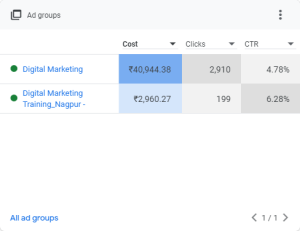
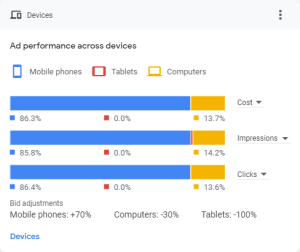
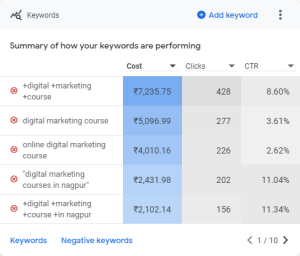
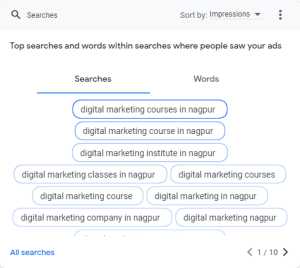

As you can see, the search keywords, the CTR, clicks on every keyword used, the costs incurred, etc.
| Course Name | Course Fees | Cost Per Click [Avg] | ROI [Based on Conversion] |
|---|---|---|---|
| Digital Marketing Course | ₹25,000/- | ₹14.12 | 267.85 times the investment |
- Suppose, the course fee is ₹25,000/- and we are getting leads at ₹14/-
- Imagine, we get 100 leads.
- Cost incurred: 14*100 = 1400.
- Useless clicks: 14*500 = 7000.
- If out of 100, let’s say 15 leads convert and enroll for the course.
- Our earnings: 15*25000 = ₹3,75,000/- [Approximately 45 times of the invested amount]
So, just understand that Google Ads is need-based. People search a query, they get the relevant result. If you are a relevant result in the search engine result pages, you can see the impact of Digital Marketing on Consumer Behaviour with simple keywords and search-based Google Ads.
Personalization and tailored advertising
These are powerful tools that businesses can use to reach their target audience and drive sales. By collecting data about their customers’ online behavior, businesses can create personalized marketing campaigns that are tailored to each individual’s needs and interests.
This type of advertising is more likely to capture the customer’s attention and lead to a sale.
The impact of digital marketing on consumer behaviour can be easily understood with ads as they present us with the factual data of consumer behaviour on our ads:
- How do they interact?
- What is the lead quality?
- How much cost is incurred?
- Is the audience relevant and specific?
One of the most effective ways to personalize the customer experience is through the use of social media. Social media platforms allow businesses to collect a wealth of data about their customers, including their interests, hobbies, and even their purchasing habits. This data can then be used to create targeted ads that are specifically designed to appeal to each customer.
For example, a clothing store might use social media to collect data about its customers’ fashion preferences. The store could then use this data to create targeted ads that feature clothing that is specifically tailored to each customer’s taste.
In addition to social media, businesses can also use personalization and tailored advertising through email marketing, website retargeting, and even in-store experiences.
By collecting data about their customers’ online behavior, businesses can create personalized marketing campaigns that are more likely to reach their target audience and drive sales.
Mobile Marketing and its Influence
If your plans don’t include mobile, your plans are not finished.
Mobile marketing is an important part of digital marketing, and it can influence consumer behavior in several ways. With the increasing use of smartphones and mobile devices, businesses can now reach their customers on the go and engage with them in a more personalized way.
Location-based services are a powerful tool that mobile marketing can use. These services can provide consumers with relevant and timely information based on their physical location.
For example, a clothing store could send a notification to customers who are nearby, offering them a discount on a specific item. This type of targeted marketing can be very effective, as it provides consumers with information that is relevant to them at the moment.
Another way that mobile marketing can influence consumer behavior is through using push notifications. Push notifications are messages that are sent directly to a user’s mobile device, even when the app is not open.
These notifications can be used to remind consumers about upcoming events, sales, or new products. They can also be used to provide customers with real-time updates on their orders or shipments. Push notifications can be an effective way to stay in touch with customers and keep them engaged with your brand.
Mobile marketing also enables businesses to track consumer behavior and preferences. This information can be used to create more targeted and effective marketing campaigns.
For example, a business could use data on customer purchases to send them personalized emails with recommendations for similar products. This type of personalized marketing can be very effective, as it shows customers that you understand their needs and interests.
Overall, mobile marketing is a powerful tool that can be used to influence consumer behavior in several ways. By reaching consumers on the go, providing them with relevant and timely information, and tracking their behavior, businesses can create more targeted and effective marketing campaigns that will drive sales and build brand loyalty.
Some facts about mobile marketing
- 37% of consumers are more likely to buy from a website optimized for mobile devices.
- 18% of mobile users will leave a website if it does not load within 5 seconds.
- 52.2% of all website traffic is generated from mobile phones.
- 52% of PPC clicks come from mobile users.
- 96% of people use Google when searching on mobile devices.
YouTube marketing and its impact on customer decision
YouTube marketing has a significant impact on customer decision-making, as it provides an engaging and immersive platform for brands to connect with their audience.
Research has shown that YouTube ads positively influence purchase intentions, with 93% of customers stating that video is beneficial when buying a product or service.
Key aspects of YouTube marketing’s impact on customer decision-making include:
- Increased engagement: YouTube videos can be more engaging than text-based content, leading to higher viewer retention and a stronger connection with the brand.
- Social proof: Viewers are more likely to trust a brand if they see positive reviews and testimonials from other users in the form of comments or video responses.
- Influencer marketing: Collaborating with YouTube influencers can help brands reach a wider audience and build trust with potential customers.
- Personalization: YouTube’s algorithm can help brands target specific audiences based on their interests and viewing history, leading to more relevant and personalized content.
- Shortened customer journey: YouTube can help shorten the customer journey by providing immediate access to product information and reviews, leading to faster decision-making.
To maximize the impact of YouTube marketing on customer decision-making, brands should focus on creating high-quality, engaging content that resonates with their target audience. They should also consider collaborating with influencers and leveraging social proof to build trust and credibility with potential customers.
Myntra Case Study
Myntra – India’s leading e-commerce platform specializing in fashion.
Objective: Establish a presence in the competitive beauty and fashion space on YouTube, focusing on subscriber growth, watch hours, view duration, and video views.
Challenge: Navigate the saturated YouTube landscape dominated by established influencers in Beauty and Lifestyle niches.
Solutions:
- Conducted thorough topic and keyword research.
- Introduced long-form compilation videos to increase watch duration.
- Optimized video titles and descriptions for better search visibility.
- Added timestamps and hashtags for improved search algorithms.
- Enhanced channel UI with consistent thumbnails, intros, and outros.
- Implemented internal linking for user engagement.
- Leveraged YouTube Shorts for increased reach.
Results:
- Subscriber acquisition improved by 140% in 5 months.
- Organic watch hours increased by 238%.
- Average view duration grew by 107.35%.
- Video views from organic sources increased by 67%.
Infidigit’s strategies significantly contributed to Myntra’s YouTube channel growth over 5 months.
Impact on consumer decision-making
Digital marketing has a significant impact on consumer decision-making. This section will discuss how digital marketing techniques, targeted advertising, social media platforms, online reviews, and digital marketing campaigns influence consumer perceptions and purchase decisions.
Digital marketing techniques such as targeted advertising, social media platforms, and online reviews can influence consumer perceptions and purchase decisions. Targeted advertising allows businesses to reach specific demographics and tailor their messages accordingly.
Social media platforms provide a space for consumers to interact with brands and other consumers, and user-generated content (UGC) on social media can significantly impact consumer trust and decision-making. Online reviews can also play a major role in shaping consumer perceptions of a brand and its products or services.
Case Study: Burger King
Burget King is a fast-food sector leader in a highly competitive market. Keith J. Kramer and Matthew Burns, his wife’s uncle, launched the company in 1953 in Jacksonville, Florida.
It is the second largest hamburger chain in the United States, following McDonald’s, with around 14,000 locations in roughly 100 countries across the world.
Mobile Marketing campaign objective
The ad, produced by the firm David SP, aims to promote the BK Express option, which lets customers order and pay online while avoiding restaurant queues.
The campaign also aimed to demonstrate the brand’s individuality and attitude, as well as confront its biggest rival, McDonald’s, while also increasing app downloads and, as a result, income.
Solution
- To increase engagement and give the ad campaign a cool atmosphere, Augmented Reality technology was used. The video ad campaign was first aired on YouTube in Brazil in 2019, but it swiftly traveled beyond the country.
- The advertisement launched the Burger King app’s AR function, which allows users to realistically set fire to the brand’s competitors’ ads in exchange for a free Whopper.
- The promotion operated as follows: customers had to download the Burger King app and scan any ad from a rival fast food company using their smartphone camera. The program would then overlay a flame effect over the ad, transforming it into a Burger King advertisement.
- The consumer would also receive a ticket for a free Whopper, which they could redeem at their nearest Burger King shop. The program could recognize any sort of advertisement, including billboards, flyers, coupons, periodicals, and even internet content.
Results
The ad on YouTube had 99,000 views and 350+ Likes, and its popularity swiftly spread throughout the Brazilian market. Overall, the campaign reached more than 17 million individuals, resulted in over 1.5 million interactions, and increased app downloads by 60%. The campaign also received other honors, including Cannes Lions, D&AD, Clio honors, and One Show.
Digital Marketing Influences Customers [In Both Ways]
Using digital marketing campaigns can also influence consumer decision-making. By collecting data about their customers’ online behavior, businesses can create personalized marketing campaigns that are tailored to each individual’s needs and interests. This type of advertising is more likely to capture the customer’s attention and lead to a sale.
Additionally, the use of location-based services and push notifications in mobile marketing can reach consumers with relevant and timely information, further influencing their purchase decisions.
In conclusion, digital marketing has a profound impact on consumer decision-making. By understanding the various digital marketing techniques and their effects on consumer behavior, businesses can develop effective marketing strategies that reach and engage their target audience, ultimately driving sales and revenue growth.
Digital marketing and consumer privacy
Digital marketing has revolutionized the way businesses connect with consumers, but it has also raised concerns about consumer privacy.
The collection and use of consumer data by digital marketers has led to increased scrutiny and the implementation of regulations such as the General Data Protection Regulation (GDPR).
These regulations aim to protect consumer data and give users more control over their information.
Digital marketers must now navigate a complex landscape of privacy laws and regulations to make sure they are compliant and protect the privacy of their customers. Failure to comply can result in significant legal penalties, damage to brand reputation, and loss of customer trust.
To maintain consumer trust and avoid legal repercussions, digital marketers must prioritize data security, transparency, and user consent. They must be clear about the data they collect, the purposes for which it is used, and the measures taken to protect it.
Additionally, they must provide users with easy-to-understand privacy policies and make it easy for users to control their data, such as opting out of data collection or requesting data deletion.
By respecting consumer privacy and complying with regulations, digital marketers can build trust and credibility with their customers, leading to stronger relationships and long-term business success. Striking the right balance between personalized marketing and consumer privacy is crucial for the future of digital marketing.
Future trends in digital marketing
The future of digital marketing is bright, with several exciting trends on the horizon. Artificial intelligence (AI) is expected to play an increasingly important role in digital marketing, as businesses use AI-powered tools to automate tasks, personalize customer experiences, and improve decision-making.
Video content is also expected to continue to grow in importance, as more and more consumers prefer to watch videos than read text. Influencer marketing is another trend that is expected to continue to grow, as businesses increasingly partner with social media influencers to reach their target audience. Finally, e-commerce is expected to continue to grow rapidly, as more and more consumers shop online.
By keeping an eye on these trends, businesses can ensure that they are well-positioned for success in the digital age. AI-powered tools can help businesses automate tasks such as content creation, customer service, and data analysis, freeing up time for marketers to focus on more strategic tasks.
Video content can help businesses reach a wider audience and engage with customers in a more personal way. Influencer marketing can help businesses build trust and credibility with their target audience. E-commerce can help businesses reach new customers and grow their sales.
In addition to these trends, several other factors are expected to shape the future of digital marketing. These include the increasing use of mobile devices, the growth of social media, and the increasing importance of data privacy.
By understanding these trends and learning how the impact of digital marketing on consumer behaviour is likely to help businesses, we can easily utilize it for our marketing purpose and business growth.

13+ Yrs Experienced Career Counsellor & Skill Development Trainer | Educator | Digital & Content Strategist. Helping freshers and graduates make sound career choices through practical consultation. Guest faculty and Digital Marketing trainer working on building a skill development brand in Softspace Solutions. A passionate writer in core technical topics related to career growth.

